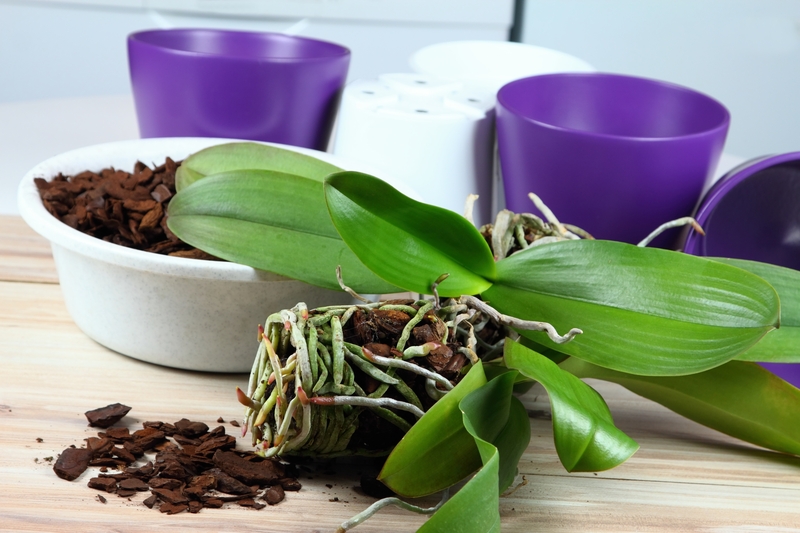A Guide to Artistic Hedge Trimming Techniques
Posted on 05/06/2025
A Guide to Artistic Hedge Trimming Techniques
Artistic hedge trimming is a fascinating art that merges horticulture with creativity. If you've ever strolled through a beautifully manicured garden and admired the whimsical shapes of boxwoods, privets, or yews, you've witnessed the magic of topiary and creative hedge sculpting. This comprehensive guide to artistic hedge trimming techniques will equip you with the knowledge and skills to transform your own outdoor spaces into stunning, living masterpieces.

What is Artistic Hedge Trimming?
Artistic hedge trimming goes beyond basic hedge maintenance. It is the practice of cutting, shaping, and sculpting hedges into intriguing patterns, shapes, and forms. From geometric outlines to lifelike animal shapes, decorative hedge sculpting is as much about aesthetics as it is about healthy plant care.
- Topiary: The ancient art of training plants into desired shapes.
- Geometric Trimming: Creating neat lines, cones, spheres, and other geometric designs in hedges.
- Freeform Sculpting: Crafting abstract or nature-inspired forms and artistic expressions in your greenery.
Let's delve deeper into the techniques, history, tools, and tips for mastering artistic hedge trimming in your own garden.
The History and Art of Topiary
Topiary dates back to ancient Roman times. It was especially prominent in European gardens of the Renaissance period, when aristocrats showcased elaborate green sculptures as symbols of wealth and sophistication. Today, creative hedge trimming is experiencing a revival, with both traditional and modern designs gracing private gardens and public spaces worldwide.
- Rome: Early records of topiary as living garden sculpture.
- Renaissance: Complex knot gardens and ornate clipped forms in castles and estates.
- Modern Era: Contemporary twists, including eco-friendly and whimsical designs.
Artistic hedge trimming blends classical inspiration with personal creativity, so your own designs can be as traditional or avant-garde as you like.
Choosing the Right Plants for Artistic Trimming
Your first step in artistic hedge sculpting is choosing suitable plants. Not all shrubs are ideal for frequent trimming or intricate shaping.
Main Considerations
- Foliage Density: Dense foliage allows for more precise shaping and crisp edges.
- Growth Habit: Plants that grow upright and branched densely lend themselves to finer details.
- Regrowth: Species that recover well from cutting make maintenance easier.
Popular Choices for Artistic Hedge Trimming
- Boxwood (Buxus): Classic, compact, and perfect for traditional topiary.
- Yew (Taxus): Slow-growing and lush, ideal for detailed forms.
- Privet (Ligustrum): Vigorous and tolerant of hard pruning, great for lively shapes.
- Holly (Ilex): Evergreen, versatile, adds a glossy finish.
- Lonicera nitida: Fast-growing and dense, excellent for creative shapes and hedges.
Explore local garden centers for varieties that thrive in your climate, as healthy, vigorous plants are essential for successful hedge trimming artistry.
Essential Tools for Hedge Trimming Artistry
Equipping yourself with the right tools ensures precision, safety, and comfort. A serious topiarist's toolkit includes:
- Hedge Shears: Long blades for smooth, straight cuts on large surfaces.
- Secateurs: For fine-tuning and detail work, especially on tight radius curves.
- Topiary Shears: Specially designed for intricate work and controlled snipping.
- Electric or Battery-Powered Trimmers: Useful for managing large or dense hedges.
- String, Stakes, and Frames: To act as guides for straight lines, curves, or complex shapes.
- Protective Gear: Gloves, safety goggles, and, for some, a face mask against allergens.
Regular sharpening and cleaning of your tools not only makes your work easier but keeps plant wounds cleaner, reducing the risk of disease.
The Fundamentals of Artistic Hedge Trimming Techniques
1. Perfecting Geometric Forms
Symmetry and proportion are crucial in geometric hedge art. These shapes--spheres, cones, cubes, and pyramids--offer visual harmony and are achievable with patience.
- Mark reference points with stakes and string or a chalk line.
- Begin by shaping the outline, then work gradually inward.
- Constantly step back to check symmetry and adjust as needed.
- Clip in stages--avoid removing too much at once, which can shock the plant or ruin the shape.
2. Creating Organic or Abstract Shapes
For more naturalistic or imaginative forms--like clouds, animals, or spirals--start with a rough idea, but allow some improvisation.
- Sketch your design or mark it with temporary garden spray paint.
- Remove stray shoots and establish primary lines and curves.
- Use hand shears for flowing shapes and intricate bends.
- Patience is essential: Some designs take seasons or years to perfect.
3. Incorporating Frames, Stencils & Guides
Frames made from wire or bamboo are invaluable for complex forms, acting as a skeleton that guides your growth and cuts. Pre-made topiary frames are available for standard forms, but DIYers can create custom guides for unique projects.
4. Layering & Perspective
Consider how your artistic hedge trimming will appear from different angles and distances. For multi-hedge designs, stagger heights or shapes for visual depth. Group similar forms for repetition, or mix forms for wild, attention-grabbing contrast.
5. Regular Maintenance
- Trim at least twice per growing season--usually in late spring and again in summer.
- Remove dead or diseased growth promptly.
- Feed, water, and mulch as needed to keep plants healthy and full.
Step-by-Step Artistic Hedge Trimming Process
Step 1: Planning Your Design
Start by researching inspiration from books, famous gardens, or online galleries. Sketch your intended design on paper, noting the plant species, orientation, and final height and width of the hedge.
Step 2: Preparing the Hedge
- Clear debris and inspect the hedge for disease or pests.
- Water the plants a day before trimming--it makes cutting easier and less stressful for the plant.
Step 3: Mark Your Shape
- Use string, stakes, or chalk lines to outline geometric shapes.
- For freeform or animal topiary, use flexible garden tape or attach a wire frame as a guide.
Step 4: Begin Trimming
- Start with the rough outline, removing large protrusions.
- Gradually define finer details, switching to smaller shears for more precision.
- Trim from the base upward; this approach prevents lower branches from being shaded and going bare.
- Step back every few minutes to assess your symmetry and adherence to the design.
Step 5: Refine and Finish
- Use hand shears to smooth edges and create clean lines or curves.
- Inspect the shape from all intended viewing angles.
- Carefully clear all clippings from the base to reduce fungal risk.
Step 6: Aftercare
- Water and mulch the trimmed hedge.
- Apply a balanced, slow-release fertilizer to promote regrowth.
- Periodically check for pests or diseases.
Popular Styles of Artistic Hedge Trimming
Classic Topiary Shapes
- Spheres and Domes: Simple and elegant for beginners and experts alike.
- Spirals: Eye-catching, best for vertical forms like box or yew.
- Cones and Pyramids: Great for formal entryways or focal points.
- Cubes and Rectangles: Crisp lines for a modern or traditional look.
Animal and Fantasy Forms
- Peacocks, rabbits, or elephants: Delightful and whimsical, common in public gardens.
- Abstract art: Create anything from giant waves to surrealist sculptures.
Contemporary Trends
- Cloud-pruned hedges: Create an organic, rolling wave effect by trimming rounded, overlapping forms.
- Living walls: Use hedges to form text, geometric illusions, or architectural features.
- Integrative designs: Blending hedges with flowerbeds, hardscape, or water features for layered artistic effects.
Tips for Successful Artistic Hedge Trimming
- Be patient: Developing complex shapes can take multiple seasons; don't rush your plants!
- Choose healthy plants: Robust, disease-free shrubs respond better to frequent clipping.
- Sharpen your tools: Dull blades tear leaves, increasing disease risk and making precise trimming difficult.
- Start simple: Master basic shapes before attempting elaborate figures or intricate forms.
- Embrace mistakes: Even seasoned topiarists prune with creativity and a willingness to adapt on the fly.
Common Mistakes in Artistic Hedge Shaping
- Over-pruning: Removing too much at once can damage or stress shrubs, slowing recovery.
- Ignoring plant health: Disease or poor soil can undermine your artistic efforts; always prioritize care.
- Forgetting the base: Allowing upper sections to shade out lower foliage creates unsightly bare stems.
- Neglecting maintenance: Even the perfect shape will blur without regular touch-ups and care.
Seasonal Considerations for Artistic Hedge Care
The best times for artistic hedge trimming are usually late spring and late summer. Trimming in early spring can encourage bushy regrowth, but avoid heavy shaping during extreme heat or cold, when plants are stressed or dormant.
- Spring: Main shaping and structural pruning, when the hedge is actively growing.
- Summer: Light touch-ups, especially for tightening detail and maintaining form.
- Autumn: Only minor trimming; avoid heavy cuts to reduce frost damage risk.
- Winter: Generally, avoid shaping, but you can assess and plan future designs when foliage reveals branch structure.
Frequently Asked Questions About Artistic Hedge Trimming
Can any shrub be used for artistic trimming?
While many shrubs can be shaped, those with dense, small leaves and strong regenerative ability--such as box, yew, holly, and privet--are the best for intricate hedge sculpture. Avoid plants with brittle branches or large leaves for fine topiary.
How long does it take to develop a mature topiary?
Simple geometric shapes may take a season or two. Ornate figures or large installations can require several years of careful training and trimming.
Is artistic hedge trimming bad for my plants?
Not if done wisely. Good technique and proper timing encourage dense, healthy growth. Over-pruning, especially in harsh weather or for unhealthy plants, can cause problems.

Inspiration: Famous Examples of Artistic Hedge Trimming
- Levens Hall (UK): Home to some of the oldest and most elaborate topiary in the world.
- Chateau de Villandry (France): Ornate knot gardens featuring complex patterns and geometric marvels.
- Green Animals Topiary Garden (USA): Over 80 animal-shaped hedges--perfect for family-friendly inspiration.
Visit public gardens or browse online galleries to spark your creativity. Every garden, no matter the size, can feature a unique piece of living art.
Conclusion: Cultivating Your Own Green Masterpieces
Mastering hedge art is both a labor of love and a living canvas for your creativity. Whether you aim for precise geometry or wild, imaginative shapes, the best results come from a blend of knowledge, patience, and practice. Start small, learn as you go, and enjoy the rewards as your garden evolves into a gallery of vibrant, living sculptures.
Artistic hedge trimming is more than just a maintenance routine--it's a way to express personality, creativity, and a passion for gardening. With the right plants, tools, and techniques, anyone can uncover the possibilities that lie within a simple hedge.
Dare to imagine and sculpt your own living works of art!



